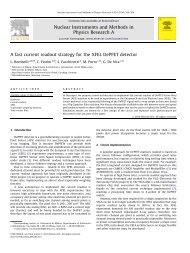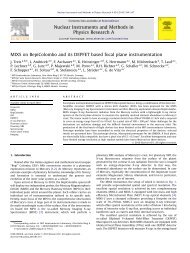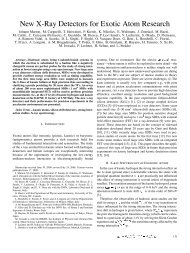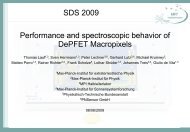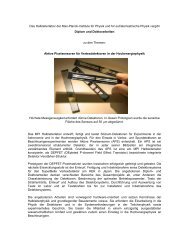Design and technology of DEPFET pixel sensors for ... - MPG HLL
Design and technology of DEPFET pixel sensors for ... - MPG HLL
Design and technology of DEPFET pixel sensors for ... - MPG HLL
Create successful ePaper yourself
Turn your PDF publications into a flip-book with our unique Google optimized e-Paper software.
2Especially <strong>for</strong> the inner layer <strong>of</strong> the TESLA vertexdetector, a lot <strong>of</strong> partially contradictionary dem<strong>and</strong>shave to be addressed. In order to meet the requiredresolution <strong>of</strong> primary <strong>and</strong> secondary vertices, theinnermost detector layer has to be placed at a radius<strong>of</strong> 15mm from the interaction point. The <strong>pixel</strong>detector at this place has to provide a spatialresolution <strong>of</strong> less than 5µm. The high occupancy,caused by the beamstrahlung, has to be suppressed bya very fast readout cycle <strong>of</strong> about 50MHz. To reducemultiple scattering, the material introduced in thedetector must be minimized. This means that no extramaterial <strong>for</strong> cooling pipes etc. is allowed <strong>and</strong>,additionally, the sensor substrates must be thinned to~50µm thickness. This results in a reduced signalcharge compared to that generated in st<strong>and</strong>ard silicondetectors, where the depletion layer extensions are <strong>of</strong>the order <strong>of</strong> 500µm. In summary, the ideal vertexdetector <strong>for</strong> TESLA should fulfill the competingboundary conditions simultaneously: High positionresolution should be achieved with small signalamplitudes, i.e. with thin detectors. Simultaneously,the operation must be fast, e.g. 20ns processing timewith low power dissipation in an environment <strong>of</strong> asignificant radiation level.The DEPleted Field Effect Transistor structure,abbreviated <strong>DEPFET</strong>, is a monolithic device which isintegrated onto a high ohmic fully depletable detectorsubstrate [3]. The device is one proposal <strong>for</strong> adetector design that is consistent to a large extentwith all <strong>of</strong> the above requirements [4]. While thesystem aspects <strong>and</strong> the readout concept are discussedin [5], this paper proposes a <strong>technology</strong> <strong>for</strong> theproduction <strong>of</strong> large area <strong>DEPFET</strong> arrays. Thedifferent operation modes <strong>of</strong> the device are evaluatedby process <strong>and</strong> device simulations. A thinningprocedure compatible to the <strong>DEPFET</strong> process <strong>and</strong> themodule concept is discussed.2. <strong>DEPFET</strong> operation principlesThe <strong>DEPFET</strong> combines detection <strong>and</strong> amplificationwithin one device [3]. It is based on the sidewarddepletion as used in semiconductor drift chambers,[6]. The principle <strong>of</strong> operation is shown in Fig.1. Ap-channel MOSFET or JFET (junction field effecttransistor) is integrated onto a silicon detectorsubstrate, which becomes fully depleted by theapplication <strong>of</strong> a sufficiently high negative voltage to abackside p+ contact. By means <strong>of</strong> the sidewarddepletion, a potential minimum is <strong>for</strong>med which isshifted directly underneath the transistor channel at adepth <strong>of</strong> about 1µm by an additional phosphorousimplantation underneath the external gate. Incidentparticles generate electron-hole pairs within the fullydepleted bulk. While the holes drift into the backcontact, electrons are accumulated in the potentialminimum, called the internal gate resulting, in amodulation <strong>of</strong> the channel current. The readout isnon-destructive <strong>and</strong> can be repeated several times.The removal <strong>of</strong> the signal charge <strong>and</strong> thermallygenerated electrons from the internal gate is calledClear. A neighboring n+ contact is pulsed at apositive voltage providing a punch-through into theinternal gate. This pulsed clear mechanism isdiscussed below in detail.Internal GateFig.1: Cross section <strong>of</strong> a <strong>DEPFET</strong> indicating the operationprinciple.Intrinsic advantages <strong>of</strong> the <strong>DEPFET</strong> device are theamplification <strong>of</strong> the signal charge at the position <strong>of</strong>its generation, thus avoiding any charge transferwhere losses could occur. The entire bulk is depleted<strong>and</strong> sensitive to incident radiation. There<strong>for</strong>e, thenon-structured backside can be used as an entrancewindow thereby improving the spectroscopicper<strong>for</strong>mance, especially <strong>for</strong> low energy photons. Themain advantage <strong>of</strong> the device is its very small inputcapacitance that provide a very low noise operationeven at room temperature. Fig.2 illustrates theexcellent noise per<strong>for</strong>mance with a measured Fe 55spectrum.<strong>DEPFET</strong> structures can be operated individually,as an integrated on-chip amplifier, <strong>for</strong> instance in thereadout node <strong>of</strong> a silicon drift chamber, orcollectively as a <strong>pixel</strong> array.


